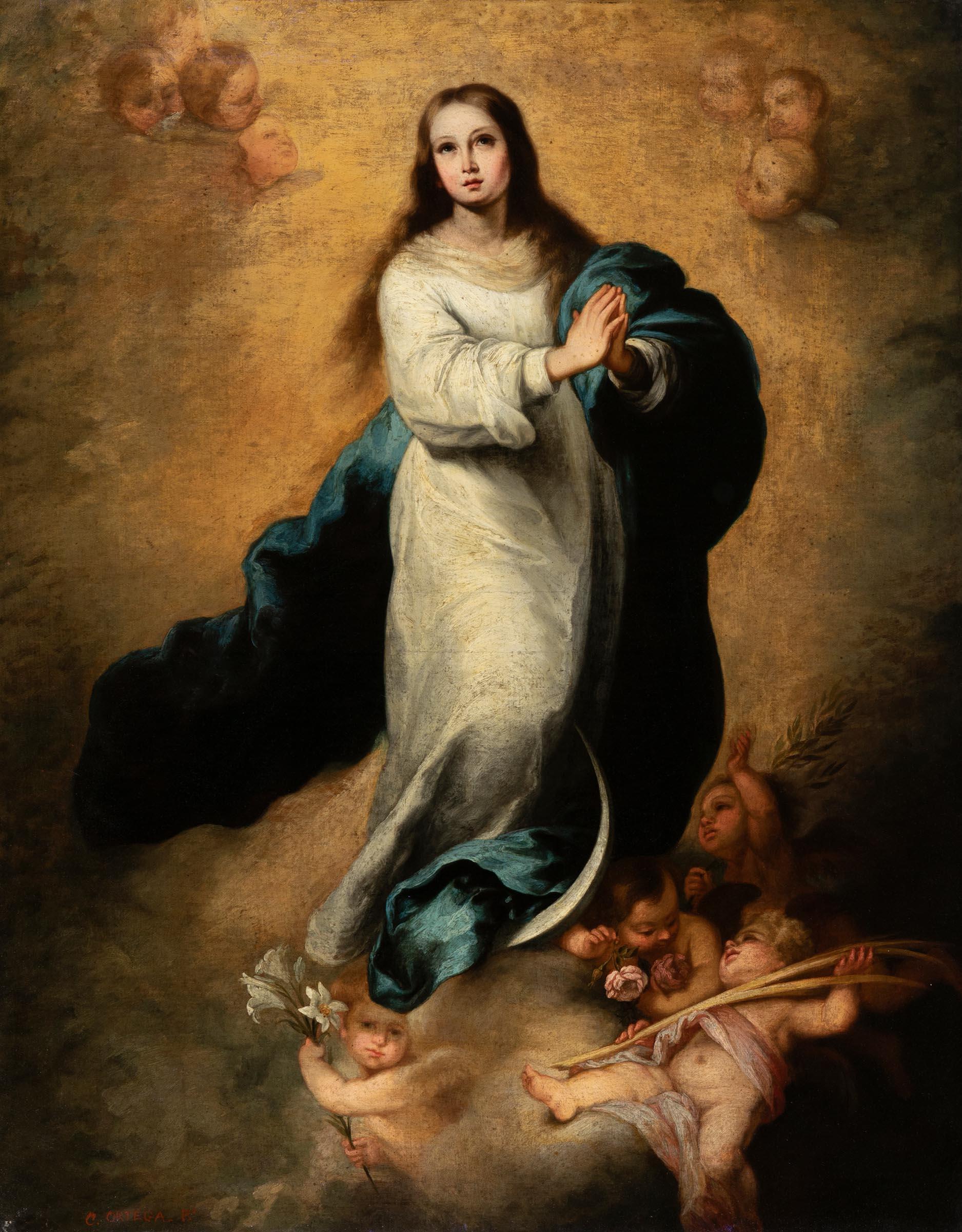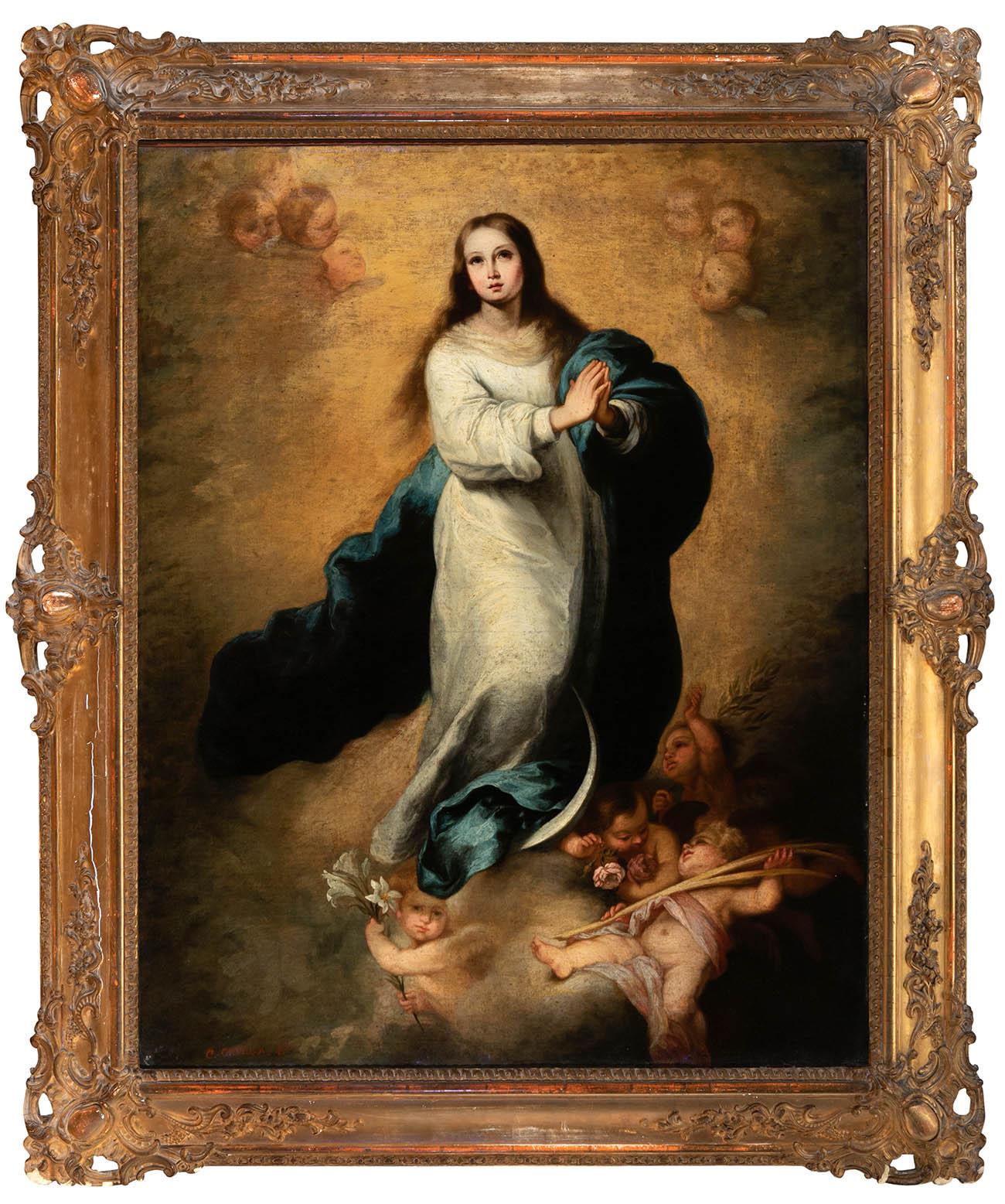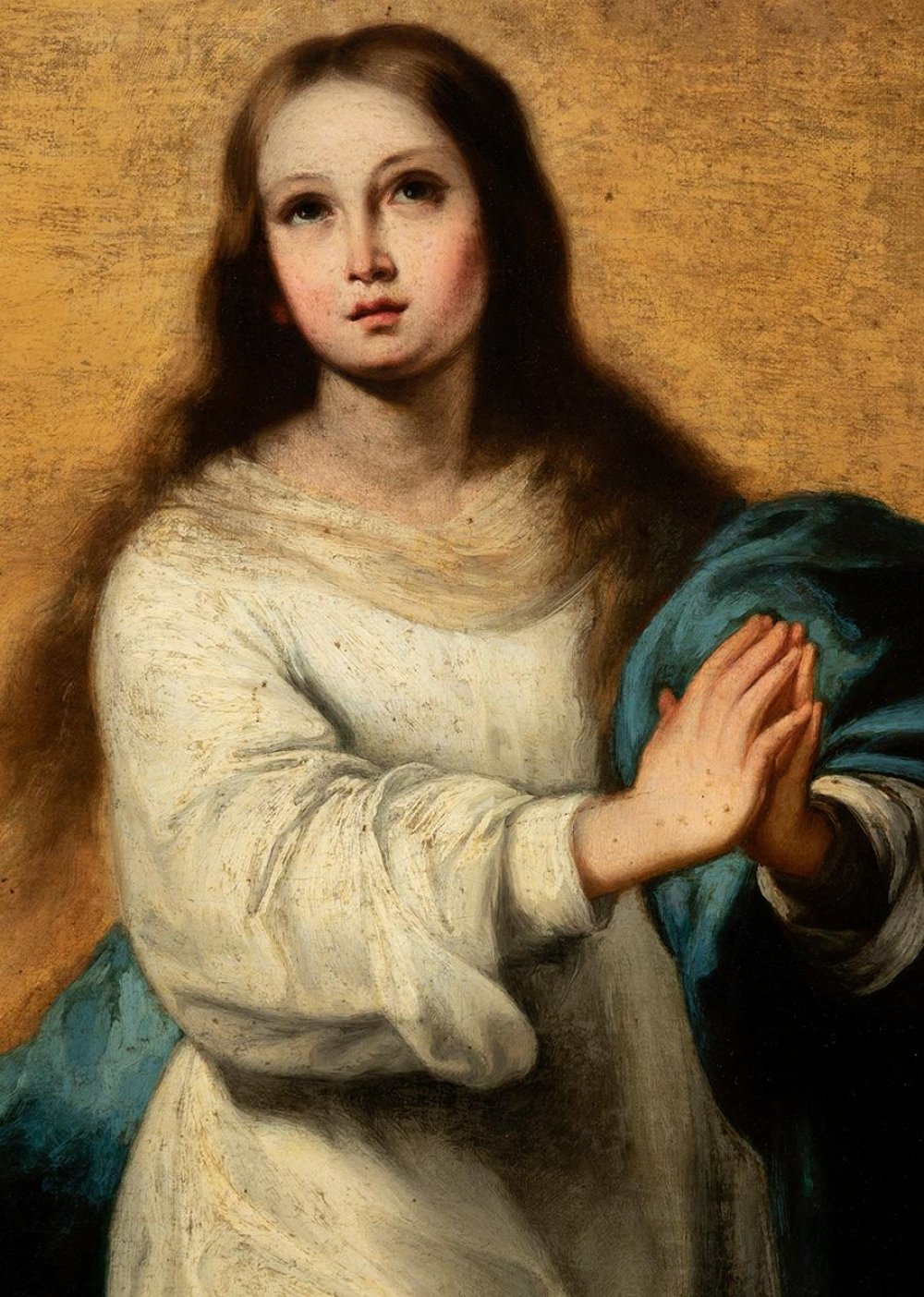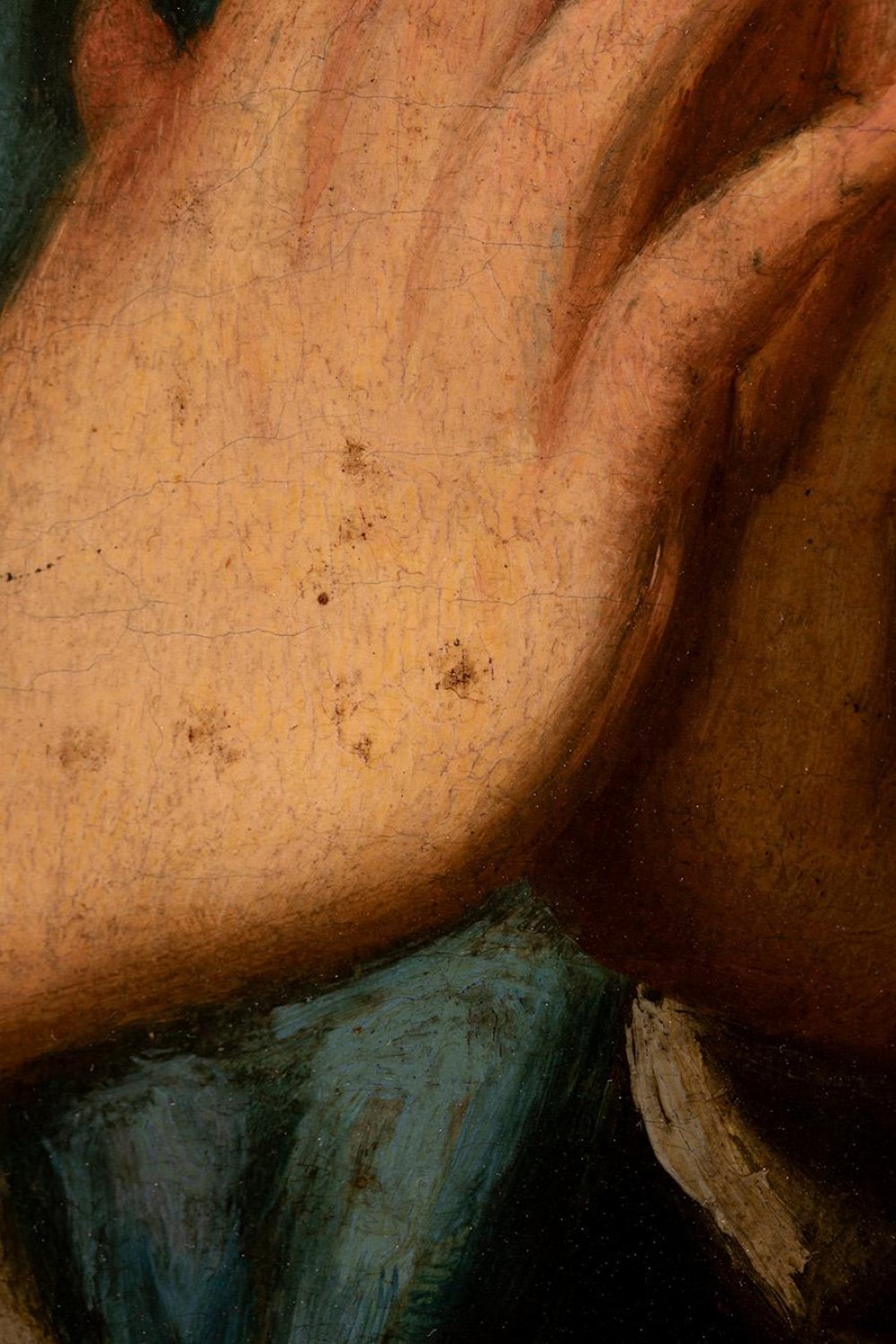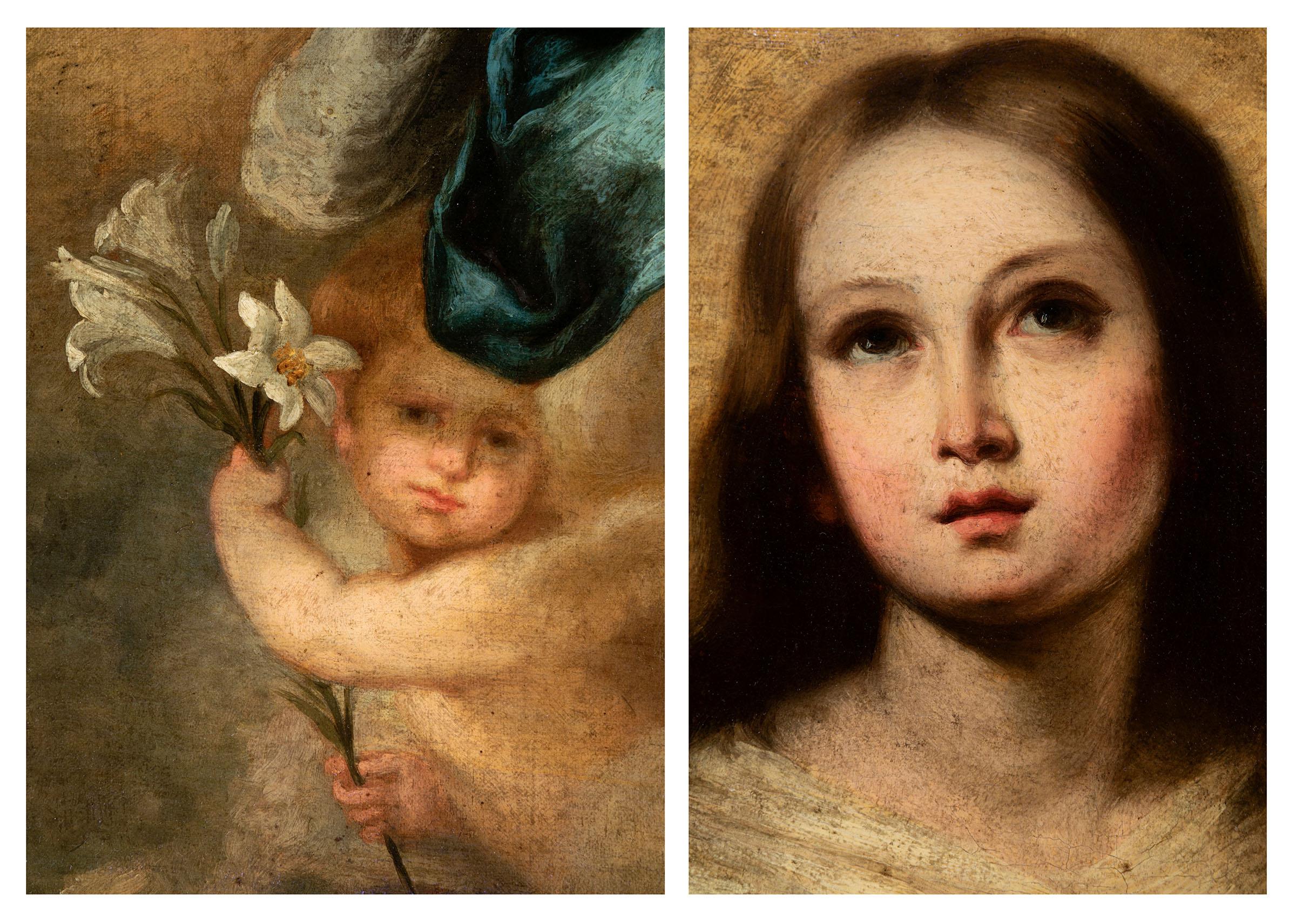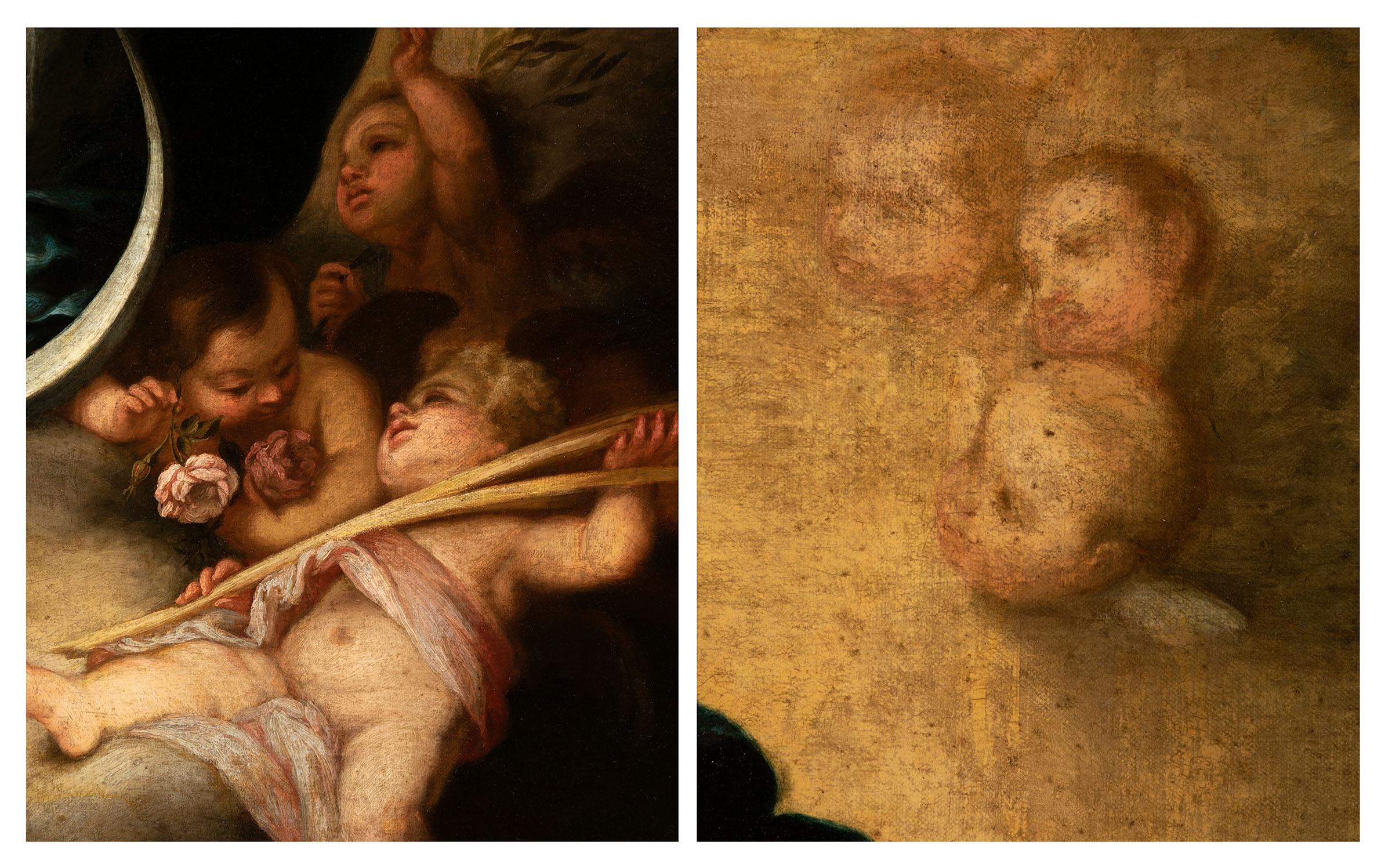7
17th century Andalusian school. Workshop of BARTOLOMÉ ESTEBAN MURILLO (Seville, 1617 - Cadiz,
"Immaculate Conception.
Oil on canvas.
Measurements: 97 x 76 cm; 121 x 100 cm (frame).
This canvas is directly inspired by "La Inmaculada del Escorial", an oil painting by Bartolomé Esteban Murillo between 1660 and 1665, today housed in the Prado Museum. The Sevillian master was inspired by a young maiden whose figure is at the centre of the canvas, her body slightly turned, her hands crossed over her heart and her gaze raised. The entire Immaculate Conception rises above a lunar crescent and is accompanied by several child angels, who appear both below her and in the upper corners, surrounding the break of Glory that surrounds the Virgin with golden light. The angels at her feet carry lilies, roses and a palm leaf, Marian symbols taken from the litanies. In the last decades of the 17th century, Murillo's emotional, sweet and delicate sentimentality prevailed in Seville over the more dramatic one of Valdés Leal, hence the predominance of his influence in the following century. As time went on, however, his influence became increasingly superficial, focusing on the imitation of models and compositions, but leaving aside his artistic language in favour of formulas more characteristic of the new century.
The theme of the Immaculate Conception, which was very common in Spanish art, came to constitute one of the signs of Spain's national identity as a Catholic country. It is one of the most genuinely local themes in Spanish Baroque painting, as Spain was the main defender of this mystery and the country that fought most insistently to make it a dogma of faith. In this context, numerous artists and intellectuals worked to construct a clear iconography that would help to disseminate the Immaculate Conception, bringing together symbolism and popular fervour.
Little is known of Murillo's childhood and youth, except that he lost his father in 1627 and his mother in 1628, for which reason he was taken into the care of his brother-in-law. Around 1635 he must have begun his apprenticeship as a painter, most likely with Juan del Castillo, who was married to a cousin of his. This working and artistic relationship lasted about six years, as was customary at the time. After his marriage in 1645 he embarked on what was to be a brilliant career that gradually made him the most famous and sought-after painter in Seville. The only trip he is known to have made is documented in 1658, when Murillo was in Madrid for several months. It is conceivable that while at court he kept in touch with the painters who lived there, such as Velázquez, Zurbarán and Cano, and that he had access to the collection of paintings in the Royal Palace, a magnificent subject of study for all the artists who passed through the court. Despite the few documentary references to his mature years, we know that he enjoyed a comfortable life, which enabled him to maintain a high standard of living and have several apprentices. The fact that he became the leading painter in the city, surpassing even Zurbarán in fame, motivated his desire to raise the artistic level of local painting.
"Immaculate Conception.
Oil on canvas.
Measurements: 97 x 76 cm; 121 x 100 cm (frame).
This canvas is directly inspired by "La Inmaculada del Escorial", an oil painting by Bartolomé Esteban Murillo between 1660 and 1665, today housed in the Prado Museum. The Sevillian master was inspired by a young maiden whose figure is at the centre of the canvas, her body slightly turned, her hands crossed over her heart and her gaze raised. The entire Immaculate Conception rises above a lunar crescent and is accompanied by several child angels, who appear both below her and in the upper corners, surrounding the break of Glory that surrounds the Virgin with golden light. The angels at her feet carry lilies, roses and a palm leaf, Marian symbols taken from the litanies. In the last decades of the 17th century, Murillo's emotional, sweet and delicate sentimentality prevailed in Seville over the more dramatic one of Valdés Leal, hence the predominance of his influence in the following century. As time went on, however, his influence became increasingly superficial, focusing on the imitation of models and compositions, but leaving aside his artistic language in favour of formulas more characteristic of the new century.
The theme of the Immaculate Conception, which was very common in Spanish art, came to constitute one of the signs of Spain's national identity as a Catholic country. It is one of the most genuinely local themes in Spanish Baroque painting, as Spain was the main defender of this mystery and the country that fought most insistently to make it a dogma of faith. In this context, numerous artists and intellectuals worked to construct a clear iconography that would help to disseminate the Immaculate Conception, bringing together symbolism and popular fervour.
Little is known of Murillo's childhood and youth, except that he lost his father in 1627 and his mother in 1628, for which reason he was taken into the care of his brother-in-law. Around 1635 he must have begun his apprenticeship as a painter, most likely with Juan del Castillo, who was married to a cousin of his. This working and artistic relationship lasted about six years, as was customary at the time. After his marriage in 1645 he embarked on what was to be a brilliant career that gradually made him the most famous and sought-after painter in Seville. The only trip he is known to have made is documented in 1658, when Murillo was in Madrid for several months. It is conceivable that while at court he kept in touch with the painters who lived there, such as Velázquez, Zurbarán and Cano, and that he had access to the collection of paintings in the Royal Palace, a magnificent subject of study for all the artists who passed through the court. Despite the few documentary references to his mature years, we know that he enjoyed a comfortable life, which enabled him to maintain a high standard of living and have several apprentices. The fact that he became the leading painter in the city, surpassing even Zurbarán in fame, motivated his desire to raise the artistic level of local painting.
26th October - Old Masters
Sale Date(s)
Venue Address
General delivery information available from the auctioneer
Setdart offers Worldwide shipping
PICK UP IN ROOM: You can come and pick up your lots in our offices (Barcelona, Madrid or Valencia). At the moment of the withdrawal, you will be able to accept the current conditions of the lot by means of a document that you will sign.
YOU CAN SEND ANOTHER PERSON TO PICK UP: This person must present a signed authorization that you can find in our web page by accessing from BUY AT SETDART- LOGISTICS-DOWNLOAD AUTHORIZATION DOCUMENT. You can also send an e-mail with the requested data in AUTHORIZATION DOCUMENT to admin@setdart.com
Important Information
25% buyer´s premium
21% buyer´s premium at www.setdart.com
Terms & Conditions
The maximum period to pay the lots is 7 working days. You can pay either via bank transfer or with credit card through our platform www.setdart.com (we only accept VISA or Mastercard).
BUYER´S PREMIUM: 22% Hammer price + 21% VAT from the buyer´s premium
If your piece has more than 100 years, our Ministry of Culture requires an export certificate in order for the piece to leave the country. Note that if the piece goes inside the EU, there is no cost for the export certificate. If the piece goes outside the EU, there is a cost for the export certificate. You can find more information in our Ministry of Culture website: https://www.culturaydeporte.gob.es/en/cultura/patrimonio/exportacionimportacion/exportacion/tasas.html
INQUIRIES: admin@setdart.com
Setdart guides you through the entire process, from the time of award to the day you receive your lot. Our logistics team will be happy to manage your transport, and will advise you on the best shipping method with professionals from the sector used to handling works of art and jewelry.
WE OFFER WORLDWIDE DOOR TO DOOR SHIPPING
PICK UP IN ROOM: You can come and pick up your lots in our offices. At the moment of the withdrawal, you will be able to accept the current conditions of the lot by means of a document that you will sign.
YOU CAN SEND ANOTHER PERSON TO PICK UP: This person must present a signed authorization that you can find in our web page by accessing from BUY AT SETDART-LOGISTICS-DOWNLOAD AUTHORIZATION DOCUMENT. You can also send an e-mail with the requested data in AUTHORIZATION DOCUMENT to admin@setdart.com
SETDART IS NOT RESPONSIBLE FOR THE STATE OF THE PARTS ONCE THEY LEAVE OUR FACILITIES. MRW SHIPMENTS: Once the payment is made, your lot will be packed for shipment, the logistics department will send you an e-mail notifying you of the day it leaves our warehouse, changes of address cannot be made after receiving this e-mail.
INSURANCE INCIDENTS: Coverage for the value of the auction up to 3000 ? per shipment, if the value of the auction is higher, Setdart will send you a quote including the additional insurance. The insurance company WILL NOT BE RESPONSIBLE FOR THE SHIPMENT THAT EXCEEDS THAT AMOUNT AND IS NOT FULLY INSURED. MRW INCIDENTS: Maximum notification 48 hours after receipt, after which the insurance company WILL NOT BE RESPONSIBLE AND NO CLAIMS WILL BE ACCEPTED.
E-MAIL LOGISTICS: logistica@setdart.com
PICK UP YOUR MESSAGES: You can send your own messaging, prior notice via e-mail that your shipment is ready, please note 3 or 4 days in advance. This type of shipment is packaged so Setdart will provide you with a quote.
EXPENSES FOR STORAGE: We inform you that if the purchased lot is not picked up within a month, you will be charged 30€ per week per lot. Setdart Online S.L., owner of the web site "setdart.com", "setdart.net" and "setdart.org", acts as a company of Spanish nationality inscribed in the Volume 36955, sheet 182, page B-293056 of the Mercantile Registry, with registered office at Calle Aragó















